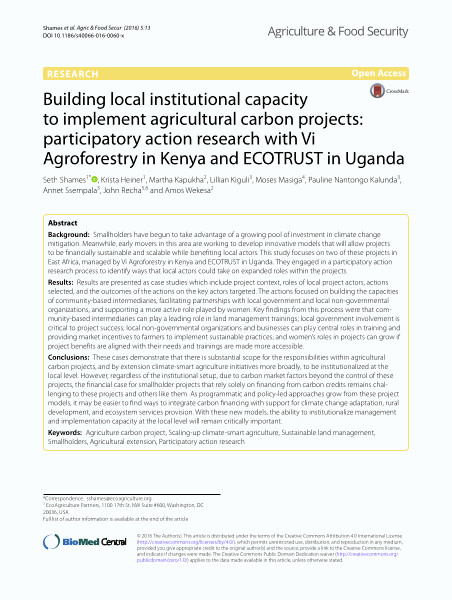Building local institutional capacity to implement agricultural carbon projects: participatory action research with Vi Agroforestry in Kenya and ECOTRUST in Uganda
Abstract
Background: Smallholders have begun to take advantage of a growing pool of investment in climate change mitigation. Meanwhile, early movers in this area are working to develop innovative models that will allow projects to be nancially sustainable and scalable while bene ting local actors. This study focuses on two of these projects in East Africa, managed by Vi Agroforestry in Kenya and ECOTRUST in Uganda. They engaged in a participatory action research process to identify ways that local actors could take on expanded roles within the projects. Results: Results are presented as case studies which include project context, roles of local project actors, actions selected, and the outcomes of the actions on the key actors targeted. The actions focused on building the capacities of community-based intermediaries, facilitating partnerships with local government and local non-governmental organizations, and supporting a more active role played by women. Key ndings from this process were that com- munity-based intermediaries can play a leading role in land management trainings; local government involvement is critical to project success; local non-governmental organizations and businesses can play central roles in training and providing market incentives to farmers to implement sustainable practices; and women’s roles in projects can grow if project bene ts are aligned with their needs and trainings are made more accessible. Conclusions: These cases demonstrate that there is substantial scope for the responsibilities within agricultural carbon projects, and by extension climate-smart agriculture initiatives more broadly, to be institutionalized at the local level. However, regardless of the institutional setup, due to carbon market factors beyond the control of these projects, the nancial case for smallholder projects that rely solely on nancing from carbon credits remains chal- lenging to these projects and others like them. As programmatic and policy-led approaches grow from these project models, it may be easier to nd ways to integrate carbon nancing with support for climate change adaptation, rural development, and ecosystem services provision. With these new models, the ability to institutionalize management and implementation capacity at the local level will remain critically important.

